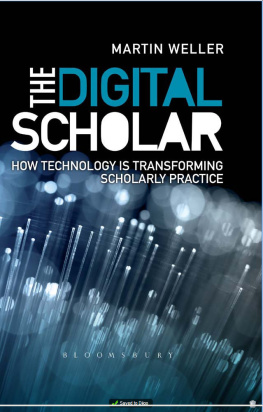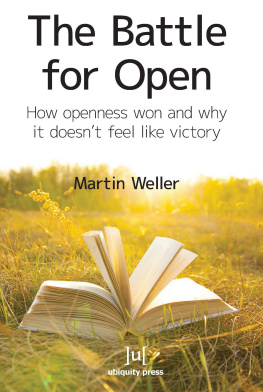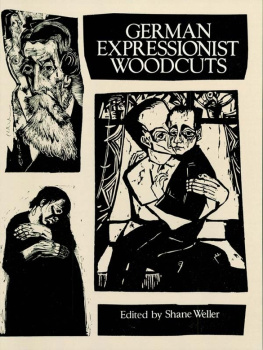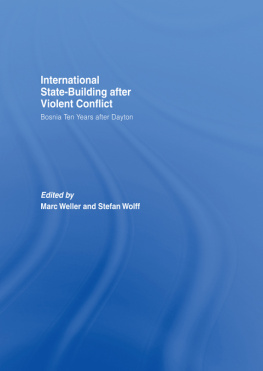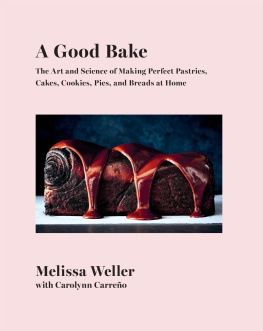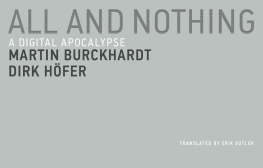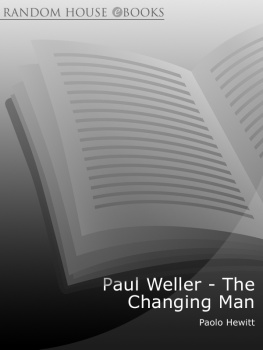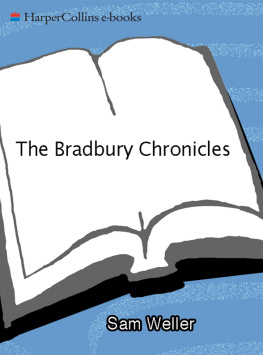Martin Weller - The Digital Scholar
Here you can read online Martin Weller - The Digital Scholar full text of the book (entire story) in english for free. Download pdf and epub, get meaning, cover and reviews about this ebook. year: 2011, publisher: Bloomsbury Academic, genre: Romance novel. Description of the work, (preface) as well as reviews are available. Best literature library LitArk.com created for fans of good reading and offers a wide selection of genres:
Romance novel
Science fiction
Adventure
Detective
Science
History
Home and family
Prose
Art
Politics
Computer
Non-fiction
Religion
Business
Children
Humor
Choose a favorite category and find really read worthwhile books. Enjoy immersion in the world of imagination, feel the emotions of the characters or learn something new for yourself, make an fascinating discovery.
- Book:The Digital Scholar
- Author:
- Publisher:Bloomsbury Academic
- Genre:
- Year:2011
- Rating:4 / 5
- Favourites:Add to favourites
- Your mark:
- 80
- 1
- 2
- 3
- 4
- 5
The Digital Scholar: summary, description and annotation
We offer to read an annotation, description, summary or preface (depends on what the author of the book "The Digital Scholar" wrote himself). If you haven't found the necessary information about the book — write in the comments, we will try to find it.
The Digital Scholar — read online for free the complete book (whole text) full work
Below is the text of the book, divided by pages. System saving the place of the last page read, allows you to conveniently read the book "The Digital Scholar" online for free, without having to search again every time where you left off. Put a bookmark, and you can go to the page where you finished reading at any time.
Font size:
Interval:
Bookmark:

How Technology Is Transforming Scholarly Practice
Martin Weller
BLOOMSBURY ACADEMIC
First published in 2011 by
Bloomsbury Academic
an imprint of Bloomsbury Publishing Plc
36 Soho Square , LondonWiD3QY, UKand
175 Fifth Avenue, NewYork, NY10010, USA
Copyright Martin Weller 2011

This work is published subject to a Creative Commons AttributionNon-Commercial Licence. You may sharethis work for non-commercial purposes only, provided you give attribution to the copyright holder and the publisher. For permission to publish commercial versionsplease contact Bloomsbury Academic
CIP records for this book are available from the British Libraryand the Library of Congress
ISBN 978-1-84966-497-4 (hardback)
ISBN 978-1-84966-617-6 (paperback)
ISBN 978-1-84966-625-1 (ebook)
Visit http://bloomsburyacademic.com/to find out more about our authors and their books. You will find extracts, author interviews, author events and you cansign up for newsletters to be the first to hear about our latest releases andspecial offers.
Coverimage: PeterPhoto123/Shutterstock
To Ellen
Whileindustries such as music, newspapers, film and publishing have seen radicalchanges in their business models and practices as a direct result of newtechnologies, higher education has so far resisted the wholesale changes wehave seen elsewhere. However, a gradual and fundamental shift in the practiceof academics is taking place. Every aspect of scholarly practice is seeingchanges effected by the adoption and possibilities of new technologies. Thisbook will explore these changes, their implications for higher education, thepossibilities for new forms of scholarly practice and what lessons can be drawnfrom other sectors.
This book has grown out ofa number of converging projects and interests, some of these related to myinstitution, the Open University (OU), some from research and others from myonline network.
In my workplace at the Institute of Educational Technology at the OU, thereare a number of colleagues who I have worked with on various projects andtalked through many of the issues in this book. These include Patrick McAndrew,Grainne Conole, Eileen Scanlon, Doug Clow, Nick Pearce, Josie Taylor, WillWoods, Sam Kinsley and Karen Cropper amongst many others. Elsewhere in the OU,Tony Hirst has acted as my archetype for a digital scholar, and John Naughtonshowed me the power of blogging before they were even called blogs. I'd alsolike to express my gratitude to all the colleagues who have patiently attendedworkshops where I have worked through these ideas and the various seniormanagers who have indulged half-baked project plans and supported the writingof this book.
My online network featuresfar too many people to list, and I fear I will offend people by not includingthem, but it would be remiss of me not to highlight the influence of earlybloggers and online contributors, including Alan Cann, George Siemens, JosieFraser, Scott Leslie, Brian Lamb, Brian Kelly, Alan Levine and Jim Groom.
I am aware that eveningswhen I should have been giving my family my full attention were occupied withwriting, or playing with stuff, so thank you to my wife and daughter forallowing me to get on with it.
But most of all, my thanksgo to all those who constitute my network, who, on a daily basis, shareresources, thoughts, links, insights and poor jokes and thus enrich myprofessional and personal life.
Dad, you know that bookyou're writing, what's it about? my daughter asked, as I walked her to school.
The elevator pitch isalways difficult for academics, who prefer to take their time to explain thingsin depth and give all sides to an argument. An elevator pitch for anine-year-old is almost impossible.
Well, I pondered, it'sabout how using technology like the Internet, dad's blog, and Wikipedia ischanging the way people like daddy work. Having recently completed a schoolproject, she was well acquainted with Wikipedia.
She considered this andthen concluded, da-aaaaad, no one's going to want to read that!
I fear she may be right,but I realised I have been writing this book for the past four years, mainlythrough my blog, which I have been using to explore what the advent oftechnologies, which offer new ways of communicating, collaborating and creatingknowledge, mean for higher education. I figured if it had kept me interestedfor this long, it might be useful to share some of that with others.
So what are these new waysof working that I had hinted at to my daughter? I'll start with an example thatis in your hands now the process of writing this book. Six years ago I wrotemy last book, and halfway through writing this, I thought I'd compare the twoprocesses. Below is a list of some of the tools and resources I used to writethis book:
Books they were accessed via the library but increasingly as e-books, and oneaudiobook.
E-journals my university library has access to a wide range of databases, but I alsomade frequent use of others through tools such as Google Scholar and Mendeley.
Delicious/socialbookmarking as well as searching for key terms I would forage in thebookmarks of people I know and trust, who make their collections available.
Blogs I subscribe to more than 100 blogs in Google Reader, which I try to readregularly, but in addition I have cited and used many posts from other blogs.
YouTube,Wikipedia, Slideshare, Scribd, Cloudworks and other sites text is not theonly medium for sharing now, and for certain subjects these Web 2.0 services offer usefulstarting points, or overviews, as well as insightful comment.
Myown blog I have kept a blog for around five years now, and it provided auseful resource for items I have commented on and drafts of sections of thisbook. I also keep a scrapbook-type blog using Tumblr where I post anyinteresting links or multimedia and revisited this for resources I hadharvested over the past few years. The blog was also a means of posting draftcontent to gain comments and feedback, which could then be incorporated intofurther iterations of writing.
Socialnetwork my Twitter network is especially useful for gaining feedback, askingfor suggestions and, on a daily basis, as a filter and collection mechanism forsharing resources.
Workand personal network undoubtedly working in an intellectually livelyenvironment and having face-to-face discussions with colleagues have beeninvaluable.
Googlealerts I have set up alerts for a few key phrases which would then provide mewith daily email updates on new content containing these keywords. This allowedme to find new resources, track conversations and stay abreast of a field whichwas changing as I wrote the book.
Seminarsand conferences my attendance at face-to-face conferences has declined due toother commitments, but I regularly attend or dip into conferences remotely (see Chapter 10 for a more detailed exploration ofthe changing nature of conferences).
If I compare this with thetools I used when I wrote my last book in 2004, then many of these services didnot exist or were in their infancy. Of this list I probably used books,journals and face-to-face conferences, with maybe some initial exploration ofblogs.
In many ways the changesare not dramatic books and journal articles still constitute a large part ofthe information sources I draw upon, although inspection of the references sectionwill reveal the significance of blogs in particular. And the output of all thisis still that most traditional of information sources, a book. But the changesare also significant for three reasons, I would suggest. First, the quantity ofthis information that is available online has increased considerably. I couldaccess nearly all of it from my desk at home; there was no need to visit aphysical library or bookstore. The digitisation of relevant content was almosttotal for the information sources I required for this book, compared with abouthalf of that in 2004. The second factor is the significance of my onlinenetwork in the writing process. I have around 3,000 followers in Twitter andaround 2,000 subscribers to my blog (often they are the same people), whichrepresents a wide pool of experience to draw upon. Sometimes I would put out adirect call to this network, along the lines of Does anyone have a goodexample of . In other cases I would post drafts of the content to my blogand receive comments and links to relevant material. Even without these directappeals this distributed, global peer network represents an invaluableinformation source, comprising links to resources, commentary on issues,extended debate, use of new methods and technology, and contributions in theform of blog posts, videos and audio. This last item leads me to the thirdsignificant difference from the previous book, which is the range and varietyof content that I drew upon. Even six years ago the type of content was largelylimited to journal articles and books. Now, this has diversified to includeblog posts, videos, draft publications, conference presentations and also thediscussion, comment and debate surrounding each of these. The change from 2004is partly a result of the first factor, quantity. There is just more of thisstuff around. But it is also a result of a shift in attitude (at least on mypart), in the legitimacy of these other forms of output and their central,vital role in everyday scholarly activity.
Next pageFont size:
Interval:
Bookmark:
Similar books «The Digital Scholar»
Look at similar books to The Digital Scholar. We have selected literature similar in name and meaning in the hope of providing readers with more options to find new, interesting, not yet read works.
Discussion, reviews of the book The Digital Scholar and just readers' own opinions. Leave your comments, write what you think about the work, its meaning or the main characters. Specify what exactly you liked and what you didn't like, and why you think so.

